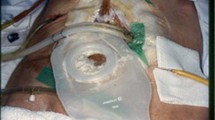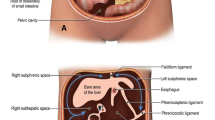Summary
The first part of this paper deals with a description of the physiopathology of acute intestinal intussusception in infants. The second, experimental part of this work, describes the investigation of 15 autopsy specimens with a detailed examination of the anatomy of the ileocecal valve in three cases. The results of this study allow to identify several factors possibly involved in the pathogenesis of infantile intussusception. These factors include: anterior insertion of the terminal ileum with respect to the cecum; decreased rigidity of the colon due to the absence of the teniae coli; papillary arrangement of the ileocecal valve; and participation of the longitudinal muscle fibers of the colon in the constitution of the valve.
Résumé
Après un rappel physio-pathologique de l'invagination intestinale aiguë du nourrisson, les auteurs font une étude anatomique de 3 valves iléocaecales, parmi 15 pièces plus particulièrement étudiées dans les Laboratoires d'Anatomie et d'Anatomie Pathologique de Clermont-Ferrand. A l'issue de cette étude, plusieurs facteurs anatomiques et histologiques pouvant entrer en jeu dans la pathogénie des invaginations du nourrisson ont été mis en évidence: insertion plus antérieure de l'iléon terminal; moindre rigidité du colon par l'absence de bandelettes; type papillaire de la valve iléo-caecale; participation des fibres musculaires longitudinales à la constitution de la valve.
Similar content being viewed by others
References
Bidet B (1970) Invagination intestinale et plaque de Peyer. Thèse Med n∘ 697d, Nantes
Borner C, Lierse W, Schreiber HW (1981) Die Biakonstruktion der Valva ileocaecalis des Menschen. Langenbccks Arch Chir 354:147–155
De Carvalho CA, Faintuch JJ, Cintra AJD (1972) Morphofuctional study on the veins of the tela submucosa of the ileocolic junction. Acta Anat (Basel) 83:248–261
De Carvalho CA, Costacurta L, Furlani J, Nogueira JO (1974) Beitrag zur Kenntnis der Submucosavenen der menschlichen Valva ileocaecalis. Anat Anz 135:495–503
DiDio LJA, Anderson Marion C (1968) The “sphincters” of the digestive system. The Williams and Wilkins Co, Baltimore
François H (1978) Contribution à l'étude du mécanisme des invaginations intestinales de la région iléo-caecale du nourrisson. Mem CES Anat Gen Organogen, Clermont-Ferrand
Issert B (1981) L'invagination intestinale aiguë du nourrisson et de l'enfant. Etude d'une série homogène de 55 cas dans le Service de Chirurgie Infantile de Clermont-Ferrand. Thèse Méd n∘ 25, Clermont-Ferrand
Kahle W, Leonhardt H, Platzer W (1973) Taschenatlas der Anatomie, Bd 2. Georg Thieme Verlag, Stuttgart
Muller G, Smith-Agreda J (1963) Form und Funktion der Regio ilecaecalis. Morphol Jahrb 104:1–26
Negre E (1943) Innervation du carrefour iléo-caeco-appendiculaire. Thèse Méd n∘ 106, Montpellier
Paolaggi JAE (1954) Le sphincter iléo-caecal. Thèse Méd n∘ 1052, Paris
Poirier P, Charpy A (1912) Traité d'anatomie humaine. Tube digestif. Acad Med Librairie, Paris
Rouvière H (1967) Anatomie humaine descriptive et topographique, 10e ed. Masson, Paris
Rutherford AH (1914) The ileo-caecal valve. Lewis, London
Scheye T (1982) Données anatomiques et histologiques concernant la valve iléo-caecale de l'enfant et de l'adulte. Tentative de corrélation avec la survenue d'invaginations intestinales aiguës cryptogénétiques du nourrisson. Thèse Med n∘ 82d, Paris XIII
Schreiber HW, Lierse W, Verner B (1978) Schleusenmechanismen im Verdauungskanal. Munch Med Wochenschr 120:1705
Stieve H (1928) Über die Bedeutung venöser Wundernetze für den Verschluß einzelner Öffnungen des menschlichen Körpers. Dtsch Med Wochenschr 54:84–90, 13–133
Testut L, Latarjet A (1931) Traité d'anatomie humaine, Tome IV. Doin, Paris
Tillaux P (1892) Traité d'anatomie topographique. Asselin et Houzeau édit, Paris
Author information
Authors and Affiliations
Rights and permissions
About this article
Cite this article
Schéyé, T., Dechelotte, P., Tanguy, A. et al. Anatomical and histological study of the ileocecal valve: Possible correlations with the pathogenesis of idiopathic intussusception in infants. Anat. Clin 5, 83–92 (1983). https://doi.org/10.1007/BF01798978
Issue Date:
DOI: https://doi.org/10.1007/BF01798978




